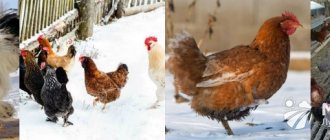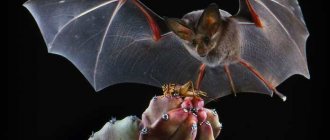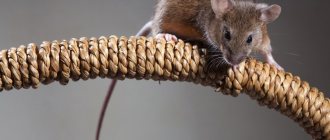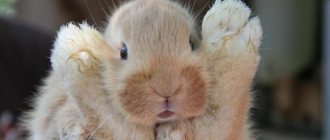What you need to know about pregnancy in rats. How their behavior and feeding habits change. Organization of space, what to change in the cage. The birth of babies is what changes life itself. What kind of nutrition does the female require? When can the cubs be resettled? Tips and tricks for breeding decorative pet rats.
If you are planning to breed decorative pet rats, you will need to study a lot of important information that will help you avoid fatal mistakes. You should know at what age mating is allowed, what care a pregnant rat needs and what nutrition it requires, what is needed for the born cubs and their mother. Next, we will look at these issues in more detail and understand the features of pregnancy in rats.
Puberty
Sexual maturity in females occurs at a very early age - 6 weeks. At this age, they have their first heat and physiologically they can become pregnant. But at such a young age, pregnancy is extremely undesirable. The fact is that the body has not yet fully formed and become stronger. The body is not ready for such stress as pregnancy and childbirth.
Experienced breeders recommend waiting until the age of 4-5 months, when the female is stronger and the body is fully formed. Regarding males, they mature for mating at the age of 7-8 weeks and at this age are ready for mating.
Development of baby rats by day
Newborn rat pups are like celluloid toys, as they are born completely without hair, blind and with closed ear canals. The only thing they can do well is suckle milk. Thanks to its nutritional value, the rapid development of rat pups begins from the third day. Their ears open and they can now hear sounds. On days 5–6, the skin becomes covered with spots and hair begins to appear. Babies become active at 8–10 days. They are already starting small fights over their mother's nipple.
When do baby rats open their eyes?
At about two weeks of age, particularly large rat pups open their eyes. The rest will catch up with them very quickly. By this time, babies have already acquired small teeth and are trying to feed on their own.
Mommy is going through a troublesome period. The cubs strive to explore the world around them, and the female constantly tries to gather them into the nest, saving them from imaginary dangers.
When can you pick up baby rats?
The human scent on newborn rat pups can cause the mother to eat them, so it is not advisable to touch them.
At the beginning of the third week, you can safely begin to accustom the babies to hands, if the female does not show aggression. Otherwise, it is better to wait a few more days so that the rat stops protecting its offspring so zealously.
When should young animals be transplanted?
Although pet stores sell decorative rats from 3 weeks of age, there is no need to rush into this. In this case, they grow up weaker and get sick more often.
The brood is hatched at approximately 26–28 days, sorting the pups by sex.
Pairing
In order for pregnancy to occur, breeders will need to study their pets and select the most favorable time for mating. The fact is that every 4-6 days estrus occurs, which lasts about 12 hours; it is during this period that pregnancy can occur. The first half of estrus is most favorable for conception. It is believed that this time guarantees an almost 100% positive result.
It is impossible to keep different-sex individuals in the same cage, so the owner must be able to determine when estrus occurs and unite the animals for mating.
The onset of estrus can be determined by the following signs:
- The sex loop becomes red and wet.
- Changes in behavior are noticeable; if you stroke the female on the back, she will bend it and raise her butt; trembling of the ears is also possible.
- It is noticeable that the female shows interest in the opposite sex.
For the mating process, it is better to move the animals to neutral territory. If this is not possible, the meeting should take place in the male's cage. The cage needs to be installed in a room where there is no one, so that nothing disturbs or distracts them. Only the feeder and water bowl should be left in the cage, all distracting objects should be removed.
At the first stage, the animals will get to know each other, sniff each other and lick each other. Next, the female begins to perform a mating dance, she spins in place, which shows her readiness to mate and attracts the male.
The mating process itself lasts about a minute, but there is no need to rush and separate the animals. One mating may not bring a positive result; it is recommended to leave them alone for a while so that there is more than one mating.
Profession and business sphere
Natural charm helps Rats in their professional activities. Sociability, energy, friendliness - all this makes it easy to charm colleagues and managers. This is why the Rat is especially successful in activities that involve constant contact with people.
The Rat has excellent organizational skills. She can be an ideological mastermind or think through the details of an event. He prefers to plan in advance, but changes in plans unsettle him. The Rat keeps promises and demands the same from others. She doesn't like frivolous and unreliable people.
Such a person keeps everything under control, even the little things. He is a realist and practitioner; he does not like to deviate from the plan. He strives to achieve his goals at any cost. Therefore, they are often workaholics who are able to work for days. At the same time, assertiveness, activity and energy are maintained.
Even in the business sphere, the Rat is rather a loner. She prefers to rely solely on herself. He does not expect gifts from fate or others. Even pleasant surprises are usually stressful - it seems as if there is some kind of catch.
Despite his penchant for secrecy, the Rat easily controls people. She easily wins the trust of others, and her talkativeness and sociability make her the soul of any company. Yielding to pressure and charm, people often follow the Rat’s lead. This is sometimes used to her advantage. Often, the Rat is prone to intrigue and the implementation of secret plans. This allows you to achieve a lot in life at the expense of others.
The talent of a manipulator does not scare people away. After all, he is complemented by wonderful qualities that attract others like a magnet. The Rat is a born diplomat and retains a huge amount of information in its memory. She is a wonderful conversationalist, knows how to listen and gives valuable advice. A calculating mind, coldness, pragmatism and seriousness - all this allows you to give valuable recommendations to others. And most importantly, she helps with deeds, and not just with words - however, if this does not conflict with her interests.
When choosing a profession, the Rat prefers intellectual work. Working with her hands attracts her less. These people make wonderful speakers and politicians, journalists and writers. They can also be teachers. Their innate sense of taste makes them excellent designers, fashion designers and artists. Integrity and a sharp mind are well revealed in the profession of an investigator, lawyer, and prosecutor.
Rats are capable of developing in business and commerce. They rely on their own strengths and are not afraid of hopeless situations. Despite the openness, direct conflicts with others are rare. But if they do happen, such a person acts very quickly and harshly.
Another area that Rats are good at is psychology, medicine and literature. Everything related to human understanding. This is facilitated by an increased interest in people and the ability to dive into the depths of one’s consciousness.
Making a career for the Rat is as natural as breathing. It turns out easy, but not always directly. She prefers winding paths, occupying the position of a gray eminence. Influence usually goes far beyond the boundaries of the position held, and authority is always high. In addition, Rats are valued for their conscientiousness - they strive to complete any work.
How to understand that a female is pregnant
The very first sign by which you can find out whether pregnancy has occurred or not is estrus; the animal looks normal in appearance. If it is absent, then the conception was successful.
Over time, changes in behavior and appearance are observed:
- Appetite increases, and more and more often the rodent can be seen eating near the feeder.
- The weight of the animal increases, the belly becomes more rounded.
- The nipples become swollen.
- It should be understood that changes occur in the body and in hormonal levels, so the animal sleeps more, becomes calm and less active.
- Starting from the middle of pregnancy, the female prepares for the birth of her cubs and begins to build nests.
In the second week of pregnancy, the belly becomes noticeably larger. At this stage, pregnancy not only becomes visually noticeable, but with a light touch on the tummy you can feel the small developing babies, they look like small peas.
You need to touch the rat's belly with the utmost caution; it is forbidden to press or make sudden movements, as this can easily harm the fetus. It is recommended to handle the animal as little as possible during pregnancy.
Habitat
They prefer to live in basements, sewer pipes, garbage dumps, port facilities, and in some cases they inhabit the first floors of buildings. They can be found not only on the first floors, but also in the attics of buildings. However, in the latter case, the presence of rats on the top floors is not in the nature of settlement, but is a temporary inspection of the territory.
The choice of habitat is related to the structural elements of the building: the presence of easily chewable sound and heat insulating materials. Spaces behind suspended ceilings and technical corridors also become places of settlement. If there are garbage chutes in buildings, first of all, the premises near the garbage chutes are populated: basements and structural elements of buildings associated with the garbage chute. They can make burrows under container platforms.
Nests are built from various debris, and the nest is divided into sections: food storage, nesting, emergency exits. They need water to survive, so they establish their colonies close to water sources, as close to them as possible. In colonies there are dominant and subordinate individuals. Some colonies may number hundreds of individuals. Despite popular belief, rats are not aggressive and attack only in conditions of starvation and when life is threatened.
Rat settlements are represented by groups, each of which occupies a certain territory and differs in the number of individuals included in its composition. Each settlement has its own activity zone and research zone. In the activity zone, feeding occurs and the bait is eaten first, as a rule, this is the area near garbage disposals. The study area can extend vertically and horizontally in occupied buildings and is characterized by irregular movements of rats.
In summer and winter, there is a seasonal decline in rats in buildings - this is due to the colonization of open areas in the warm season and the death of offspring in the winter.
How long does pregnancy last
Gestation of the cubs averages about 21-24 days. It is worth saying that the timing may depend on several factors, which include:
- Age of the female.
- The number of cubs carried.
- Health status.
- Number of pregnancies before.
It happens that while feeding your offspring, the next pregnancy occurs; this is quite difficult for the body, since a lot of energy and health are spent. In this case, the next pregnancy will last longer.
On average, from 8 to 15 cubs are born, but it happens differently; she can give birth to just 1 little rat or produce offspring of 20 little rats. She feeds large litters quite easily, she has 12 nipples and there is enough feeding for everyone.
Year of the Rat - characteristics of a child
The rat is popular due to its sociability. She always keeps up the conversation with interest, but rarely establishes deep relationships. True friends are a value for such people. If they do appear, then this is a connection for life. Loyalty and reliability are above all else for Rats.
She has enough acquaintances and friends. But the Rat itself keeps its distance from people, not letting them get too close to itself and not telling personal things about itself. Sometimes it even looks arrogant. Loneliness does not bother her. Occasionally, outbursts of melancholy occur, and then a person thinks about the need for devoted friends. But this happens extremely rarely.
The Rat is attentive to its surroundings, gathering interesting personalities around itself. As a rule, these are people of authority and with a bright personality. Rats closely monitor public opinion and monitor their image. They are very concerned about what others say and think about them. But if a person has reached certain heights, they stop taking into account the opinions of others. They think that you won’t be nice to everyone.
However, Rats also have negative traits. Likes change - sometimes such a person can treat others like toys. Either he strives to communicate and shows attention, then he moves away without ceremony. Especially these traits can be enhanced by awareness of one’s strength and power. The Rat tends to gossip and often criticize others. Criticism is not always constructive.
With close communication, other traits are revealed: nervousness, aggressiveness, pedantry to the smallest detail. Rats often have a choleric temperament. They can explode out of nowhere if they don’t like something about the little things. In addition, these people are reserved and hardly talk about their mental and physical suffering. They are good at keeping not only their own, but also other people's secrets.
Conditions of detention
So, after mating, the female is separated from the male, then she only needs rest. Be sure to remove all entertainment accessories, hammocks, and tunnels from the cage. If the cage is two-level, access to the second level is closed.
Place as much filler as possible on the floor; it must be of good quality. When using wood chips, remember that they should not collect dust; if this is not the case, replace them with another filler. All this is done for safety reasons for the rodent and her babies.
The cage should contain only what is necessary:
- Feeders, you will need two of them.
- Drinking bowl.
- We need a house, if there was one, it will need to be replaced with a more spacious one.
The cage must be placed in a place that will be protected from bright light and drafts. If there are cats or dogs in the apartment, limit their access to the pregnant animal.
Closer to birth, the animal will begin to arrange a nest - she will need pieces of fabric and napkins, so make sure that they are available in the cage in advance. Do not forget that rats also require the attention of their owners, which is why it is recommended to handle them and stroke them, but with the utmost care.
Limiting factors for rat numbers
Apart from the active human activity of exterminating rats, as well as the hunting of cats as human agents, the rat population suffers from:
- natural predators (weasels, stoats, snakes, birds of prey);
- own aggression and cannibalism (fights with a bloody outcome, eating cubs and rivals);
- underdevelopment of cubs and their dependence on the mother;
- many infectious diseases.
And yet there are a lot of rats, a person has to constantly fight with them. Why? The answer is simple - they are very smart, well organized, eat everything, and are distinguished by courage and arrogance in hunting and survival. In pantries and basements they show miracles of ingenuity, opening even cans, not to mention plastic containers. So the confrontation between man and rat has the character of an eternal war.
Hygiene
While your rat is pregnant, be sure to keep the cage clean. Cleaning should be carried out at least every 5 days. The last cleaning should be done 5 days before the start of labor, by thoroughly washing all the equipment and scalding it with boiling water.
The house and tray should be disinfected and the filler replaced. The bedding must always be kept clean and dry so that the animal does not inhale harmful fumes of ammonia and hydrogen sulfide. Please note that you can only wash the cage using baking soda; household chemicals are prohibited.
Initial care of offspring
Newborn rats are difficult to feed and must be kept warm at all times. Infants raised without their mother should be stimulated to eliminate waste (with a damp, warm Q-tip or cotton swab).
A breastfeeding foster mother will give babies a much better chance of survival. Survival rate when grown independently is very low.
Newborn rats require food and drink. The healthiest initial feeding should be colostrum, a secretion from the mammary gland produced shortly after birth. It is rich in antibodies that help keep babies healthy. Colostrum also contains a lot of carbohydra.
Feeding
A pregnant rat should eat well. At this time, variety is needed in her diet; the pet should receive more protein, vitamins and minerals. The grain mixture should be given in the same volumes as before the start of pregnancy.
In addition, the rat needs to be fed such foods as:
- Lean meat;
- Fish;
- Cottage cheese;
- Chicken cartilage;
- Vegetables – carrots, zucchini, cucumbers;
- Fruits – apples, pears;
- Fresh greens - nettle, dandelion, plantain leaves.
Another good option is baby food; you can choose meat, fruit, and vegetable purees. There are no preservatives or salt in the composition, which is why it is healthy.
While pregnant, you should avoid consuming the following foods:
- Liver;
- Grape;
- Milk;
- Egg yolks;
- Tomatoes;
- Onion;
- Garlic;
- Cabbage.
The cage should be equipped with branches of fruit trees, since they are an additional source of vitamins, and they are also an excellent tool for grinding down the incisors. A lick stone with minerals should be constantly available. Also make sure that there is always clean water in the drinking bowl.
Veterinary intervention
At a veterinary practice, specialists may do an x-ray or ultrasound to see how many babies are left in the uterus, as well as their position. The female does not need to be sedated for x-rays.
- Oxytocin injection
Your veterinarian may try to induce labor with oxytocin. This is especially helpful for postpartum-exhausted rats whose contractions have become too weak to produce pups.
Oxytocin is a hormone produced by the pituitary gland that increases the ability of sodium molecules to pass into the muscles of the uterus, causing the uterus to contract. These muscle contractions move the babies through the birth canal. Oxytocin is also necessary during lactation. Oxytocin, given by your veterinarian, is a synthetic hormone that is used if your rat is having weak or no contractions.
Caution should be exercised when prescribing oxytocin. If the baby rat is positioned incorrectly or its large body is stuck in the birth canal, the stronger contractions produced by the medicine may cause the uterus to rupture. An x-ray will help your veterinarian visualize the babies' position and decide whether an injection of oxytocin is needed.
In some cases, labor begins after the first injection, but slows or stops again. In this case, repeat dosing may be necessary to ensure that all babies can be born. Oxytocin should not be administered to a rat during labor more than two or three times.
- Emergency caesarean section
A Caesarean section is a procedure in which the offspring is born by cutting the abdomen and uterus, as opposed to a normal birth.
Since it is impossible to give birth to babies and repair the uterus in rats, the procedure is a virtual sterilization. The uterus is removed and opened to save all viable children and the mother.
Your veterinarian should use all routine sterile surgical procedures, including sterile draping. The veterinarian may pre-treat the rat with Torbutrol or Banamine (for pain) and Glycopyrrolate (for heart protection). The rats will be given Isoflurane or Sevoflurane for surgery.
A female after a cesarean section will not be able to breastfeed due to stress after the operation and lack of hormones. Ask your veterinarian to give her pain medication. You give it to a rat at home - it is a very invasive and painful procedure.
Although not every emergency sterilization results in a live birth, often some or all of the children survive. They will need help to complete the birth process.
After the hysterectomy, a veterinarian will need to care for the mother while an assistant or more will help with the offspring. This needs to be done quickly. Babies stuck in the birth sac without oxygen may struggle to breathe and aspirate birth fluids.
Each uterine horn will be carefully cut so that none of the babies are harmed. When babies are removed, each sac will be carefully opened and the umbilical cord cut approximately 3.5cm from the body. Afterwards, babies will be wiped with a warm sponge or cloth. Next, they are dried by gently and constantly rubbing. It is important to make sure their mouth and nasal passages are clean. It's normal if they don't start breathing right away; it may take a few minutes of stimulation to breathe.
It is necessary to constantly rub babies and periodically bring them to a source of pure oxygen (to an oxygen tube during rubbing). This can even revive purple or blue babies.
Possible problems
The owner of a rodent must be attentive to the condition of the rodent. Most cases are normal, but complications rarely occur. And the problems that arise can lead to stress.
Urgent veterinary care should be provided in the following situations:
- Lethargy and lack of appetite in the rat;
- Discharge of pus and blood from the genital loop;
- Lack of movement of the pups in the abdomen can be detected in the last stages of pregnancy;
- The duration of labor takes more than 5 hours.
Reproduction of wild rats
In the wild, rats do not live very long.
Like all rodents, they breed in large numbers, eat a lot and grow quickly. In this respect they are somewhat similar to insects and can therefore sometimes reproduce to large numbers under the right conditions. In the wild, rats don't live very long.
Rarely do rats live more than a year in the wild. However, during this year they can create many new rats and cause great damage to the environment. Just one adult female can give birth to more than 40 new rats per year.
Pregnancy in rats lasts from 21 to 23 days, and each rat produces three to six offspring during its life. However, wild rats do not outnumber humans because there are some things that keep their population from getting out of control.
Rodent control inspectors, food shortages and affordable housing are keeping their numbers low, while disease and predators also keep their population levels in check.
In the wild, rats also fight each other and may engage in cannibalism.
Childbirth
Before giving birth, the rodent loses its appetite, but the need for water, on the contrary, increases, and the rat becomes thirsty. It is better to install the drinking bowl in advance closer to the nest. On the day when childbirth occurs, blood is released from the genital tract.
On this day, the animal is in the house and wants privacy. They often give birth at night; the animal does not need human help and under no circumstances should you interfere with this process. She independently accepts each cub and gnaws the umbilical cord. Then she licks the babies and feeds them milk.
Due to the fact that the rat licks the babies, the newborns' lungs open and blood circulation increases, which allows the babies to breathe on their own. It happens that dead fruits are born and the animal eats them.
The birth itself lasts 1-3 hours, the first is the longest, the subsequent ones are shorter. During this period, it is forbidden to touch the rat; it may become aggressive. At the end of labor, she drinks water and starts feeding.
Birth
The birth begins. One by one, the babies will move through the birth canal and be pushed out. They can be born either with the head or the back of the body. The female rat can pull out the baby with her paws and teeth, tearing off the placenta and birth sac.
She licks the membrane to clear the airways. Licking also helps oxygenate the blood. After cleaning the newborn, she will ingest the placenta and umbilical cord, membranes rich in protein. The movement and sound of the newborn will prevent the mother from swallowing it. Sometimes, when a baby rat is stillborn, the mother may swallow it after birth.
This process is repeated over and over again until the entire litter is born.











